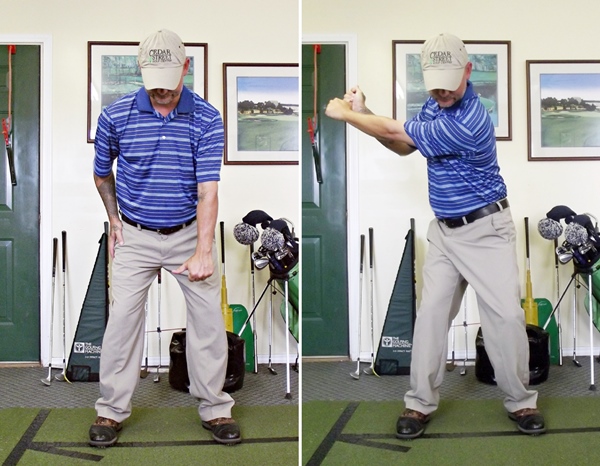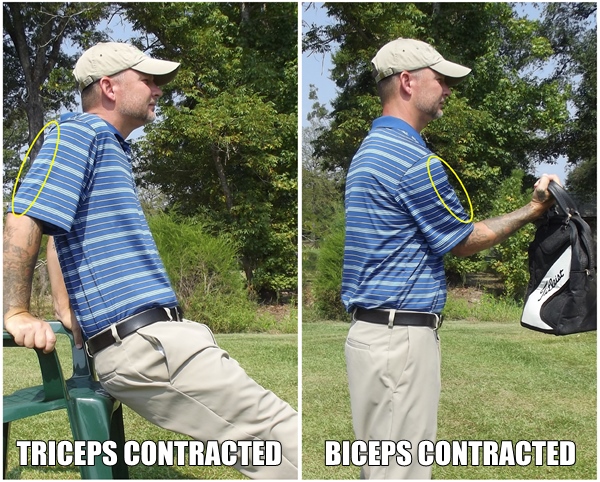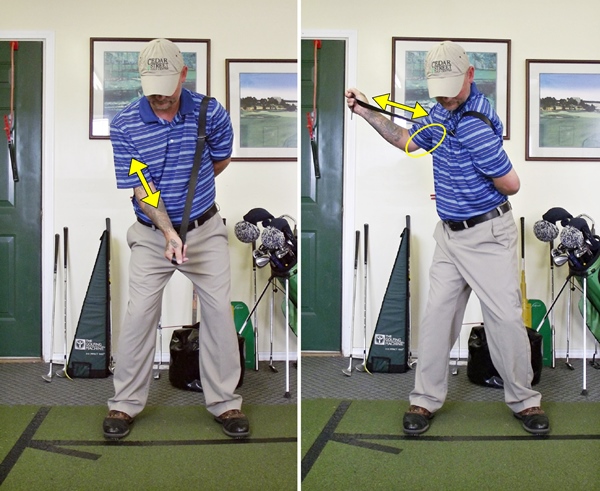Instruction
The bent left arm and drills to fix it

In this article, I will be addressing the breakdown of the left arm (for right-handed golfers) at the top of swing. I generally use the terms lead or trail arm when writing an instruction piece. In this case, however, I think the term “bent left arm” is synonymous with all golfers suffering from a breakdown of the lead arm during their swing.
The bent left arm is very commonly seen in young golfers who lack proper equipment, coordination or are attempting to swing much too far back. Once given lighter, age-appropriate clubs and quick example of where to stop the backswing the issue goes away.
The fix for more mature golfers is in what we will identify as extensor action. This term can be found in Mr. Homer Kelly’s book “The Golfing Machine”, chapter 6-B-1-D.
The concept is that the left arm maintains its structure from the constant pushing of the right arm. It is important to realize that golfers are simply trying to keep the left arm structured, NOT rigid or locked. What’s the difference? Adopt your golf set up, but without a club. Let your arms hang relaxed from your shoulder sockets. Your lead arm is now hanging straight.
Locking your arm at the elbow is a hyperextended condition. Before even beginning to work on your left arm, first consult with your instructor to verify the arm is bent to a degree that is actually causing a problem. Different degrees of straight can be seen even among golf’s professional players. Here are a couple of simple drills that will help you once you are certain the left arm is bent to a degree that is causing a breakdown of your hitting structure.
Top of Swing Drill
Adopt your golf set up without a club, with your arms hanging completely relaxed and left arm straight (not rigid or hyperextended). Close your left hand into a fist and then extend your left thumb. With your right hand, reach across your chest and grip your left thumb as if gripping a golf club. Now, swing to the top and feel how the pushing of your right arm keeps the left arm structured. Also notice where your shoulder turn stops and your left arm is straight. This is the true top of your golf swing. To swing beyond this point will require a breaking down of your lead arm or loss of posture and spine angle.
Triceps Awareness
The picture on the left is an example of activating the triceps muscle to keep myself from touching the chair. This triceps condition will give structure to my left arm when performing a golf swing. The picture on the right picture is an example of my biceps being contracting, which would cause my left arm to bend at the top of my swing.
Straight Through Structure
Make a loop with your belt and slide your left arm into it, including your shoulder. Adopt your golf posture and let the belt hang limp. Reach across and grip in your right hand, wrapping the belt around your index finger and pinching with your thumb. Make a backswing and keep the belt stretched tight. You will find that the only way to give the belt structure is with a constant pushing from the right triceps.
Begin working with a club, swinging to the top with your new right arm sensations. This is extensor action, and the structure that you seek. Lower handicap players can also benefit from these drills by sensing extensor action during the downstroke. Better players sometimes need to feel more width through the ball, and an earlier straightening of the right arm. The same drills apply. Simply shift your focus on maintaining right arm structure from the top of swing, all of the way into your finish. Next, hit some shots with right arm only to begin coordinating contact with your improved alignments.
- LIKE70
- LEGIT6
- WOW13
- LOL4
- IDHT0
- FLOP5
- OB1
- SHANK6
Instruction
Clement: Laid-off or perfect fade? Across-the-line or perfect draw?

Some call the image on the left laid off, but if you are hitting a fade, this could be a perfect backswing for it! Same for across the line for a draw! Stop racking your brain with perceived mistakes and simply match backswing to shot shape!
- LIKE0
- LEGIT0
- WOW0
- LOL0
- IDHT0
- FLOP0
- OB0
- SHANK1
Instruction
The Wedge Guy: The easiest-to-learn golf basic

My golf learning began with this simple fact – if you don’t have a fundamentally sound hold on the golf club, it is practically impossible for your body to execute a fundamentally sound golf swing. I’m still a big believer that the golf swing is much easier to execute if you begin with the proper hold on the club.
As you might imagine, I come into contact with hundreds of golfers of all skill levels. And it is very rare to see a good player with a bad hold on the golf club. There are some exceptions, for sure, but they are very few and very far between, and they typically have beat so many balls with their poor grip that they’ve found a way to work around it.
The reality of biophysics is that the body moves only in certain ways – and the particulars of the way you hold the golf club can totally prevent a sound swing motion that allows the club to release properly through the impact zone. The wonderful thing is that anyone can learn how to put a fundamentally sound hold on the golf club, and you can practice it anywhere your hands are not otherwise engaged, like watching TV or just sitting and relaxing.
Whether you prefer an overlap, interlock or full-finger (not baseball!) grip on the club, the same fundamentals apply. Here are the major grip faults I see most often, in the order of the frequency:
Mis-aligned hands
By this I mean that the palms of the two hands are not parallel to each other. Too many golfers have a weak left hand and strong right, or vice versa. The easiest way to learn how to hold the club with your palms aligned properly is to grip a plain wooden ruler or yardstick. It forces the hands to align properly and shows you how that feels. If you grip and re-grip a yardstick several times, then grip a club, you’ll see that the learning curve is almost immediate.
The position of the grip in the upper/left hand
I also observe many golfers who have the butt of the grip too far into the heel pad of the upper hand (the left hand for right-handed players). It’s amazing how much easier it is to release the club through the ball if even 1/4-1/2″ of the butt is beyond the left heel pad. Try this yourself to see what I mean. Swing the club freely with just your left hand and notice the difference in its release from when you hold it at the end of the grip, versus gripping down even a half inch.
To help you really understand how this works, go to the range and hit shots with your five-iron gripped down a full inch to make the club the same length as your seven-iron. You will probably see an amazing shot shape difference, and likely not see as much distance loss as you would expect.
Too much lower (right) hand on the club
It seems like almost all golfers of 8-10 handicap or higher have the club too far into the palm of the lower hand, because that feels “good” if you are trying to control the path of the clubhead to the ball. But the golf swing is not an effort to hit at the ball – it is a swing of the club. The proper hold on the club has the grip underneath the pad at the base of the fingers. This will likely feel “weak” to you — like you cannot control the club like that. EXACTLY. You should not be trying to control the club with your lower/master hand.
Gripping too tightly
Nearly all golfers hold the club too tightly, which tenses up the forearms and prevents a proper release of the club through impact. In order for the club to move back and through properly, you must feel that the club is controlled by the last three fingers of the upper hand, and the middle two fingers of the lower hand. If you engage your thumbs and forefingers in “holding” the club, the result will almost always be a grip that is too tight. Try this for yourself. Hold the club in your upper hand only, and squeeze firmly with just the last three fingers, with the forefinger and thumb off the club entirely. You have good control, but your forearms are not tense. Then begin to squeeze down with your thumb and forefinger and observe the tensing of the entire forearm. This is the way we are made, so the key to preventing tenseness in the arms is to hold the club very lightly with the “pinchers” — the thumbs and forefingers.
So, those are what I believe are the four fundamentals of a good grip. Anyone can learn them in their home or office very quickly. There is no easier way to improve your ball striking consistency and add distance than giving more attention to the way you hold the golf club.
More from the Wedge Guy
- The Wedge Guy: Golf mastery begins with your wedge game
- The Wedge Guy: Why golf is 20 times harder than brain surgery
- The Wedge Guy: Musings on the golf ball rollback
- LIKE88
- LEGIT15
- WOW6
- LOL1
- IDHT0
- FLOP4
- OB1
- SHANK8
Instruction
Clement: Stop ripping off your swing with this drill!

Not the dreaded headcover under the armpit drill! As if your body is defective and can’t function by itself! Have you seen how incredible the human machine is with all the incredible feats of agility all kinds of athletes are accomplishing? You think your body is so defective (the good Lord is laughing his head off at you) that it needs a headcover tucked under the armpit so you can swing like T-Rex?
- LIKE0
- LEGIT3
- WOW2
- LOL0
- IDHT0
- FLOP0
- OB0
- SHANK2
-

 19th Hole2 weeks ago
19th Hole2 weeks agoJustin Thomas on the equipment choice of Scottie Scheffler that he thinks is ‘weird’
-

 19th Hole2 weeks ago
19th Hole2 weeks ago‘Absolutely crazy’ – Major champ lays into Patrick Cantlay over his decision on final hole of RBC Heritage
-

 19th Hole2 weeks ago
19th Hole2 weeks agoLET pro gives detailed financial breakdown of first week on tour…and the net result may shock you
-

 19th Hole2 days ago
19th Hole2 days agoReport: LIV star turns down PGA Championship invite due to ‘personal commitments’
-

 19th Hole1 week ago
19th Hole1 week agoGary Player claims this is what ‘completely ruined’ Tiger Woods’ career
-

 Whats in the Bag2 weeks ago
Whats in the Bag2 weeks agoTeam McIlowry (Rory McIlroy, Shane Lowry) winning WITBs: 2024 Zurich Classic
-

 19th Hole3 weeks ago
19th Hole3 weeks agoTaylorMade signs 15-year-old AJGA Rolex Junior Player of the Year to an NIL contract
-

 Equipment1 week ago
Equipment1 week agoGolf fans left surprised by LIV’s choice of course for its 2024 individual championship event






















Denis
Dec 4, 2013 at 1:53 pm
I like the article a lot, thank you. I will try those ideas to at least learn more about my swing.
What I am a bit skeptical about is this part – “This is the true top of your golf swing. To swing beyond this point will require a breaking down of your lead arm or loss of posture and spine angle.” Am I correct thinking the author suggests that this should be the end of the backswing?
If yes, than I find it is not that simple.
I agree that when I move past that point, I do always break my lead arm to a some extent. However and despite that, I swing more consistently this way than if I try to stop the backswing right before the breaking point. I think it is better (my subjective opinion, of course) to swing as far back as it feels natural but not allow significant breaking of the arm (which hopefully the drills of the article will help me with). What do you think?
carlspackler
Dec 3, 2013 at 1:22 am
calvin peete fell out of a tree, his arm was actually straight for him, bent to us.
Tom Stickney
Dec 3, 2013 at 12:17 am
Homer mentioned ext action several times in 12-3-0, so it must be important! Couldn’t agree more. Most players forget about the role of the trailing arm and its control of the lead arm back and through.
Michael Howes
Feb 2, 2014 at 1:05 pm
Yes Sir, I agree with you. Trail Arm and it’s effect on Lead arm is an important relationship to understand. Even if you are a golfer who’s Lead arm is NOT an issue, you can only benefit from isolating and understanding the movements. Thx for posting!
mark
Dec 3, 2013 at 12:14 am
Of course, keeping the ‘left arm’ straight doesn’t need to apply to all players. I suppose that possibly the majority of golfers should keep the triangle intact, but it certainly isn’t necessary to play tour-quality golf (see Ed Furgol, Calvin Peete, and others for example), nor power golf (see WLDC winners Joe Miller and Ryan Winther).
I made the switch to a bent left arm to relieve stress on an injured back and have been playing my best golf ever.
jeev
Dec 2, 2013 at 11:13 pm
I will be sure to pass this article along to Kenny Perry.
Michael Howes
Feb 2, 2014 at 12:54 pm
I was going to include a picture of Kenny Perry & Lorena Ochoa with bent left arms, as well as the many with straight Left arm.
As stated at the beginning of the article “Before even beginning to work on your left arm, first consult with your instructor to verify the arm is bent to a degree that is actually causing a problem. Different degrees of straight can be seen even among golf’s professional players. Here are a couple of simple drills that will help you once you are certain the left arm is bent to a degree that is causing a breakdown of your hitting structure”
Tom
Dec 2, 2013 at 4:36 pm
I can use well over seventy five percent of this articles instruction to help me. Well done Mr. Howes.
Michael Howes
Feb 2, 2014 at 1:06 pm
Thx for posting Tom